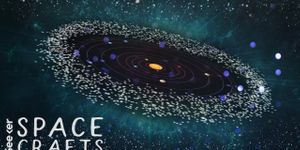The Science Behind Star Wars
Since the Star Wars series first hit the theatre four decades ago, it has created its own sci-fi culture and captivated audiences around the world. Have you ever wondered how close we are to achieve those futuristic technologies in the movies? Is it possible to create a lightsaber? Can someone build a Death Star for real? With so many advances in robotics and AI, has anyone already created a robot like R2-D2 or C-3PO?
Lightsaber
The idea that a beam of laser light can be shaped into a blade, and clash with other sword-like beams is purely imaginative. The name lightsaber is misleading since there are no laser swords (even George Lucas admitted in interviews). But there are other options to consider for building a glowing melee weapon: accelerated particles, ionized plasma gas and a newly discovered material known as photonic molecules.
Particle accelerators like cyclotrons can spin particles such as protons at high velocity and spit them out to a targeted outlet. Proton beam is an increasingly popular method for cancer radiotherapy because its emission can be conditioned to stop at a specific range without overshooting, just like the blade of a sword. But putting a particle accelerator, which comes with the size between a vending machine and a small room, inside a sword handle is almost an unimaginable task on it own.
Plasma is an ionized gas, a very hot gas. You could picture it as an extreme hot soup of atoms and electrons. Plasma can be used to build a lightsaber, but it would require very strong magnetic fields to confine the distribution of plasma so that it can form a sword shape. The good thing about the plasma is that it can explain the colors of the lightsaber: different kinds of gasses, different plasma, can create different colors.
First theoretically predicted in 2007, photonic molecules are a natural form of matter which can also be made artificially in which photons bind together to form "molecules". In a 2013 study, scientists pumped gaseous rubidium atoms into a vacuum chamber and cooled close to the absolute zero. As photons the light particles entered the gaseous cloud, their energy excited atoms along their path, causing them to be stuck within the rubidium atoms. If you designed it right, it could just be in the shape of a sword. One may excuse the delicate conditions how these photonic molecules are formed, but the mass-less existence of electromagnetic interaction can barely do any harm to anything in the path. In fact the extreme cold condition of the cloud may cause someone frostbite.
So to build a sword that cuts through metal and flesh, and comes with a colorful glow, we still have a lot to figure out.
Death Star
In the movie, the Death Star launched its lethal attack by firing up a six-beam laser that conjoined in the middle of the circle, before dealing a single, devastating photonic blow to the target. But in real life is that the six rays would pass through each other and head off in six different directions. Again, the violation of physics behind how light works make it impossible to construct a weapon that acts like the Death Star.
But how about just normal laser weapon without the fancy appearance, but as powerful as the Death Star? Laser weapon systems nowadays can deal extensive damages and have been equipped US navy vessels in defense of hostile drones, helicopters, and fast patrol craft. The directed energy (which would need stayed focus on the target for a couple of seconds to allow for damage) can burn through structures or melt holes on the object surface. In a 1998 test, a Mid-Infrared Advanced Chemical Laser (MIRACL) fired at a retiring satellite that was 432 kilometers (268 miles) above the Earth’s surface and temporarily blinded the sensors on broad. The 2.2-megawatt laser was believed to be able to melt the satellite if allowed.
The energy output of any laser weapons needs to be proportional to the amount of energy that is pumped into or generated within them. Any weapon that can blow up a planet, for example, the size of the Earth, into pieces, it would need to deliver an output of 2 * 10^32 joules, which is equal to 2.3% of the sun’s annual energy output. With such mind-blowing amount of energy, it is hard to believe anyone can power up a weapon anywhere close to the Death Star.
However, this is not to completely dismiss the possible existence of a planet killer. In fact, there is another source of power no one has imagined could destroy an entire planet—a star. A 2016 study had dug up some convincing evidence. The host star in the HIP 68468 system had likely ingested some of its planets, according to the star's composition. It contains four times more lithium and other elements that are abundant on rocky planets.
So alternatively, if you cannot afford to build a Death Star but manage to move or nudge a real star close to the target planet with other methods, it would be just as good as a Death Star.
Intelligent robots like R2D2 and C3PO
With the advances made in both robotic technology and artificial intelligence, one would expect that intelligent robots would become reality soon. Take the Curiosity rover for example, this world-renowned robotic adventurer has been working on the surface of Mars via remote control from NASA. It conducted exploratory tasks such as taking and analyzing rock samples on Mars, as well as sending the data back to Earth. Atlas, a human-like robot built by Boston Dynamics, can act more agile and nimble than both R2D2 and C3PO. It is now capable of doing backflips with decent success rate.
On the artificial intelligence front, Google DeepMind's AlphaGo defeated professional Go, chess, and poker champions multiple times since 2016. AlphaGo Zero, a most recent version of the system demonstrated some eerily intelligent behaviors: all previous versions learned Go by observing millions of moves of human players, AlphaGo Zero learned by playing only against itself.
So, as you see, the chance is high that someday we may have robots that possess or surpass the mobility and intelligence of R2D2 and C3PO.
What's new, Atlas? Credit: Boston Dynamics
Source: CBC/Scientific American/Wikipedia










